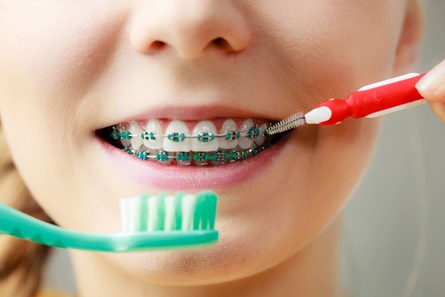Orthodontics & Braces
What is an orthodontic treatment?
An orthodontic treatment is essentially a way of moving or straightening teeth to improve the appearance of teeth and their function. Dentists will recommend orthodontic treatment for improving the long-term health of the teeth, jaw joints, and gums as it can spread the biting pressure over all the patient’s teeth.
General dentists perform basic alignment and orthodontics. However, orthodontists specialize in the correction of teeth irregularities.
Typically, questions about the health will be asked, a clinical exam will be conducted, and impressions of the teeth are taken before an appropriate treatment plan is made. In addition, photos of the teeth and face as well as X-rays of the head and mouth may also be requested.
In certain cases, a removable retainer is all that is needed to correct the condition. In cases that involve extreme underbites or overbites, surgery might be recommended. In most cases however, braces will be necessary.
Why is orthodontic treatment important?
Orthodontic treatment is used to correct a “bad bite.” This condition, known as a malocclusion, involves teeth that are crowded or crooked. In some cases, the upper and lower jaws may not meet properly and although the teeth may appear straight, the individual may have an uneven bite.
Protruding, crowded or irregularly spaced teeth and jaw problems may be inherited. Thumb-sucking, losing teeth prematurely and accidents also can lead to these conditions.
Many people have crooked or crowded teeth and orthodontic treatment is needed to straighten or move the teeth in a better position. Several treatment options that can help straighten the teeth include retainers and braces.
Correcting the problem provides many benefits, which are:
1) Boosting self esteem
With straight and evenly spaced teeth, you will likely be proud of your smile. Pride in your appearance can enhance your confidence and encourage you to try new things. This can be particularly important for adolescents. In addition, a smile that shows straight teeth can be more attractive and can help provide a good first impression.
2) Promoting Oral Health
More importantly, orthodontic treatment results in a healthier mouth. Brushing and flossing your teeth are two basic components of an oral health routine to protect your teeth which are made difficult with crooked and crowded teeth. The American Dental Association says the following conditions are less likely to occur if you have the proper orthodontic treatment.
– Dental caries
– Gum disease or gingivitis
– Tooth loss
– Impaired speech
– Worn tooth enamel
3) Orthodontic Treatment Improves Nutrition
Poorly aligned teeth can reduce your ability to chew properly or make certain foods more difficult to eat. Many of these more challenging foods are healthy and avoiding them can cause you to limit your diet to softer, often less-nutritious foods, such as ice cream and canned soup. Straighter teeth and a better ability to chew let you eat crunchy foods, such as apples; stringy foods, such as asparagus; and chewy foods, such as raisins. An improper bite can interfere with chewing and speaking, can cause abnormal wear to tooth enamel, and can lead to problems with the jaws.
Am I suitable for braces?
Braces is generally done at about 12 to 14 years old when all baby teeth have fallen off and replaced by a new set of adult teeth.
As per the recommendation of the American Association of Orthodontists (AAO), children should have their first orthodontic consultation no later than 7 years of age. While 7 years old might seem too early to consider braces, prompt pre-screening can help ensure preventative measures can be https://www.1728dental.com.sg/wp-content/uploads/2020/12/chasmerdeka_raj-1-1.jpgistered when needed to avoid braces in the future.
Nonetheless, it is increasingly common for adults to have orthodontic treatment now. The good news is that you’re never too old to have braces! Adults who think they might be candidates for orthodontic treatment should consult with their dentists so appropriate options are explored.
Typically, initial consultation with a dentist or orthodontist will involve visual evaluation of both the facial structure and teeth of the patient. If more in-depth information is needed or if treatment needs to start, diagnostic records will be requested.
The diagnostic tools can include models of the patient’s teeth, X-rays, and photographs of the patient’s teeth and face. The diagnostic records will be used to create a custom treatment plan for the patient.
When are braces necessary?
To align how they bite together (occlusion) and move teeth into their ideal position, braces are used. The misalignment of teeth between the lower and upper dental arches (with the first molars as a reference point) is called malocclusion.
According to the Angles Classification Method, there are three different misalignment types. Developed by Dr. Edward Angle, the founding father of orthodontics, the Angles Classification Method is used widely by dentists the world over.
According to the Angles Classification Method, the three types of misalignment are:
– Class I – This is considered the ideal relationship between the lower and the upper teeth. With Class I bite, spacing or crowding may be present.
– Class II – This type is more commonly known as “overbite.” The lower first molar of the patient is posterior positioned or is more towards the mouth’s back. The maxilla or the upper jaw appears to protrude forward. This type has two subclasses that describes the upper front teeth’s position. However, in both cases, the molar relationship is just the same.
– Class III – The lower first molar of the patient is closer to the front of the mouth or is positioned anterior. The mandible or the lower jaw protrudes forward. This type is often referred to as “underbite.”
Even if a patient has the ideal bite, it is possible that they can have varying degrees of spacing or crowding, yet another factor that’s associated with a misaligned bite.
Crowding causes teeth to rotate, overlap, and in some cases, become positioned incorrectly in the mouth. In extreme cases, crowding can cause the tooth to be trapped in the bone.
Crowding can occur when the adult teeth is larger than normal, or the dental arch is way too small for the adult teeth. Losing the baby or primary teeth early or retaining them longer than usual in the mouth can also result in crowding.
Aforementioned factors can inhibit the adult teeth and force it to grow or erupt into an incorrect position. Crowding can make flossing and brushing the teeth correctly difficult and may result in gingivitis or tooth decay.
Alternatively, there are also varying degrees of spacing which can occur due to jaw size or smaller teeth. The most prevalent example of spacing is between the centrals or the upper two front teeth. This is called diastema.

What other conditions can be corrected by orthodontics?
An incorrect bite and misaligned teeth can affect more than just the smile and appearance. The following conditions can be corrected through orthodontics:
- TMJ or jaw pain
- Sleep apnea secondary to snoring and mouth breathing
- Chewing and eating difficulties
- Speech impediments
- Clenching or grinding of the teeth
- Tooth decay and gum disease
Patients who experience any of the symptoms above should immediately get in touch with their dentist so the cause of the condition can be determined.
For many however, aesthetics can be a factor when deciding if braces is right for them. Correcting any concerns they may have with their teeth or facial shape might help enhance their self-confidence.
If braces is the recommended solution, an appliance that’s specific to the needs of the patient will be prescribed by the dentist or orthodontist. Braces can consist of wires, bands, and other removable or fixed corrective appliances. When it comes to braces however, no one method will work for everyone.
How long do I need to wear braces?
On average, once the braces are on, they typically remain for one to three years. After the braces are removed, most patients are required to wear a retainer for the first 6 months and wear it only during sleep for a few years.
How often do I need to see an orthodontist during treatment?
You will need to see your orthodontist every month or so to ensure the braces are exerting consistent pressure on the teeth. To create more pressure and tension on the teeth, the orthodontist will adjust the springs, rubber bands or wires of the braces.
In some instances, braces alone won’t be enough to shift the jaw or straighten the teeth. In similar cases, an external appliance like a headgear may be worn at home through the night.
Is wearing braces painful?
Will age affect the success of braces?
What happens after my braces are removed?
After your braces are taken off, your teeth will be cleaned thoroughly. Another set of bite impressions and X-rays might be taken to assess how well the teeth are straightened and to check if there are any developing wisdom teeth.
If wisdom teeth come in after the removal of the braces, your orthodontist or dentist might recommend extraction of the wisdom teeth to prevent the newly straightened teeth from shifting.
Your orthodontist or dentist may also have you wear a retainer. A retainer is a removable or fixed appliance that is custom-made and designed to help maintain the teeth’s new position after the removal of the braces.
Retainers are also sometimes used to treat minor orthodontic issues. Using retainers is a key component of post-braces care. Retainers are typically made of clear plastic, rubber, or metal wires.
After the braces have been removed, you will be required to wear retainers all the time, at least for the first 6 months. After 6 months, you can wear the retainers only during sleep.
Time frame for wearing retainers can vary from one person to another. Even after the teeth has been successfully straightened, it is possible that they have not completely settled in their position yet. Retainers are there to help ensure the teeth stays straight until the gums, bones, and muscles can adapt to the change.
















